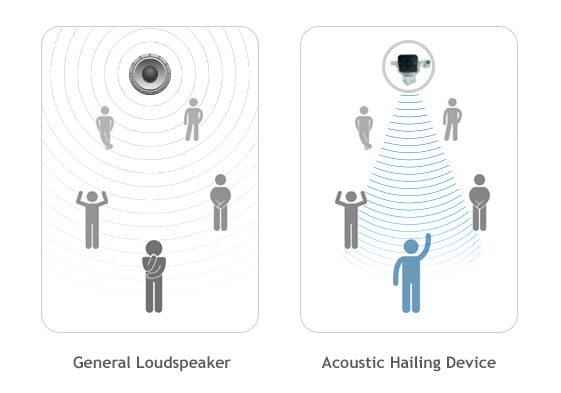PRODUCTS
What is a Long Range Acoustic Hailing Device?
It is a high powered Aoustic Hailing Device for long distances that can be used manually. Bluetooth and external USB memory are supported. MP3 file playback and microphone broadcasting are also available.
Acoustic Hailing Device PROPA-500P
| – Superior Voice Intelligibility and Highly clear communication up to 1.7 km |
| – High output of 146dB, 1.7km broadcasting distance (78dB) |
| – Bluetooth 3.0 support (connected to smartphone) |
| – External USB memory available |
| – MP3 file playback, microphone broadcast |
| – Maximum output limit available |
| – Embedded Amplifier |
| – All-weather use |
View the Products
Coming soon
PROPA-500P Components
Coming soon
| Basic Components | Additional Components |
|---|---|
|
|
PROPA-500P Specifications
| Items | Specifications | |
| Max. SPL | 146 dBA(Peak)(1m Front) | |
| Sound Projection | ±15° (2kHz Sine, -3dB) | |
| Frequency Response | 500Hz~5KHz | |
| Communication Range | 1.7km(78dB), 1km(82dB) | |
| Weight | 25kg | |
| Power Input | 100∼230VAC or 24VDC | |
| Power Consumption | Max. 1kW | |
| Operating Temperature | -30°C ∼ +60°C | |
| Audio Controller | Copy from USB memory MP3 file Playback Character LCD(Backlight) – Sunshine Readable Handheld dynamic microphone |
|
| ETC | Can limit Max. SPL for hearing protection as customer’s request. Embedded AMP |
|
Main Features of Acoustic Hailing Device
- Since it broadcasts with directivity and high power, it can transmit highly clear sounds to a long distant (1 ~ 3km).
- With maximum output above 142dB, it can get over the noise of the surrounding area and can provide large and clear communication and warning signals to the inside of vehicles, ships or buildings, overcoming the limitation of the existing broadcasting system (P.A. System).
- It is possible to broadcast using a sound source and a microphone.

Sound Pressure Level vs Distance
– 30~50dB
Quiet library, noise in the woods, bedroom
– 50~60dB
General office noise
– 60~70dB
Noise on large ship deck
– 70~90dB
Small ship engine noise (above deck)
– 80~100dB
Noisy construction site, road noise
– 120~130dB
Jet noise (100m)
– 130dB
Above, we started to feel pain
– 160dB
Rocket firing noise
– Theoretically, We can hear sounds at 88dB at 500m, 82dB at 1km, and 68dB at 5km. –
| – 30~50dB | Quiet library, noise in the woods, bedroom |
| – 50~60dB | General office noise |
| – 60~70dB | Noise on large ship deck |
| – 70~90dB | Small ship engine noise (above deck) |
| – 80~100dB | Noisy construction site, road noise |
| – 120~130dB | Jet noise (100m) |
| – 130dB | Above, we started to feel pain |
| – 160dB | Rocket firing noise |
– Theoretically, We can hear sounds at 88dB at 500m, 82dB at 1km, and 68dB at 5km. –
Environmental Certifications
- Random Vibration : MIL-STD 810F, Method 514.4
- Shipboard Vibration : MIL-STD-167-1A
- Shipboard Shock : MIL-STD-910D, Class I
- Shock : MIL-STD-810F
- High Temperature Operation : MIL-STD-810F, Method 501.4
- Low Temperature Operation : MIL-STD-810F, Method 502.4
- Operating Humidity : MIL-STD-810F, Method 507.4
- Salt Fog : MIL-STD-810F, Method 509.4
- Safety Standard : MIL-STD-1474D
- EMC Standard : FCC Part 15 Class A Radiated and Conducted Emissions
- Water and Dust Protection : IP66

Fire Evacuation Broadcast, Public Place Guide and Evacuation Broadcast, Valley Evacuation Broadcast due to heavy rain, and Coastal Accident Prevention & Evacuation Broadcast

Illegal Activity Warning, Beach Announcement, Access Control Broadcast, Crowd Control

Military Training control, Anti-Piracy, Major Facility Intruder Warning, Preserving Wildlife & Protecting Assets

Traffic Control, Prevention of Secondary Accident, Traffic Accidents and Foggy Broadcast, Emergency Evacuation Broadcast





